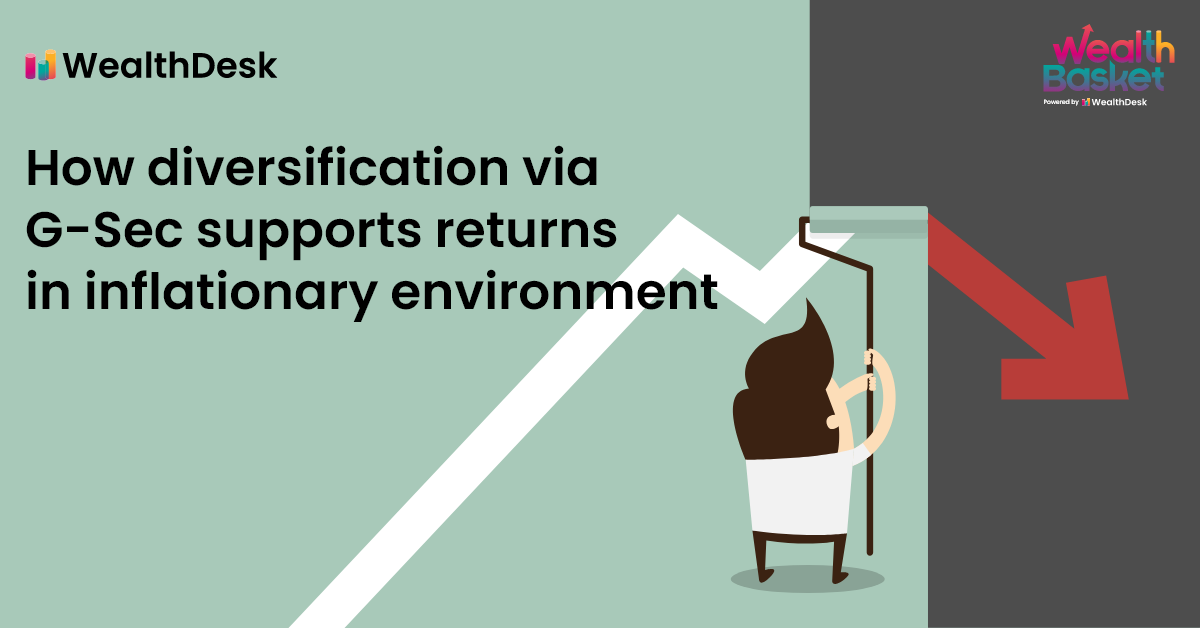This article throws light on some of the characteristics of government securities (g-secs). Why are g-secs considered risk-free? What is the relationship between interest rates and bond prices?
Read on, we answer these questions here.
What are government securities?
Government securities (g-secs) are bonds issued by the government. G-secs are structured like a loan. On maturity (end of loan term), the investors are paid the principal amount. In the case of long-term g-secs (maturity over 1 year), investors get interest payments in the form of coupon payments.
When an investor is buying government security, they are lending to the government. The Indian government has never defaulted on its debt. It is very rare for governments to default on their debt. Therefore, g-secs are called risk-free gilt-edged instruments.
What are the characteristics of government securities?
- No credit risk
- Wide range of products
- Tradeable on the secondary markets
- Subject to price variations due to interest rate changes
- Coupon payments
- Lower returns
- Who can issue government securities?
- Monetary policy tool
- No credit risk
Credit risk is the possibility of the borrower being unable to repay the loan along with the interest payments. It is very rare for governments to default on their debt. Defaulting on their debt would make borrowing funds in the future difficult and expensive. Even when countries go through major crises, they would try to avoid default. India has never defaulted on its debt.
Hence, g-secs are assumed to have no credit risk.
- Wide range of products
Government securities come in various forms and maturities. There are g-secs that don’t pay interest and g-secs that pay inflation-indexed interest. Treasury bills, offered at discount to face value, can have a maturity starting with 14 days, while dated g-secs can have maturities up to 40 years. Through Sovereign Gold Bonds, it is also possible to invest in gold through g-secs.
- Tradeable on the secondary markets
Government securities can be bought and sold in the secondary market. Until recently, investing in g-secs was restricted to banks and large financial institutions. After the roll-out of the Retail Direct Gilt Scheme, retail investors, too, can invest in g-secs.
- Subject to price variations due to interest rate changes
Bond prices vary inversely with the interest rates. After interest rate hikes, new bonds are issued with higher interest payments. Old bonds that have lower interest payments would go out of favour and experience a fall in price.
After interest rates cuts, interest rates would fall in bank savings accounts and fixed deposits. Additionally, new bonds would be issued with lower interest payments. Old bonds that have higher interest payments would become the preferred commodity for stable returns in the long term. This causes a rise in the price of old bonds.
- Coupon payments
Interest payments on bonds are called coupon payments. The interest is calculated on the face value of the government securities. These payments are calculated based on an annual interest rate and paid at certain intervals (quarterly, semiannually etc.). Investment in government securities is lucrative for people planning to have a stable income, over a longer maturity in comparison to other options like fixed deposits. Bonds may also offer better interest rates.
- Lower returns
Investing in any asset carries some amount of risk. To compensate for the risk, investors are paid a risk premium. Due to the assumed lack of risk, government securities typically do not pay a risk premium. Due to the lack of a risk premium, the returns on g-secs are lower as compared to corporate bonds or other securities.
- Who can issue government securities?
Government securities in India are issued by the Central or State governments. Central governments issue both short and long term government securities. State governments, on the other hand, issue only long-term securities called State Development Loans (SDLs). Since State governments may depend on Central governments for finance, g-secs issued by State governments have a higher yield.
- Monetary policy tool
Central banks buy and sell g-secs to control money supply for controlling inflation or spurring growth. When a central bank like RBI buys g-secs back from the domestic market, money is added to the economy. Central banks hope to promote growth by adding money to the economy, thus increasing liquidity.
When a central bank wants to lower inflation, they try to take out some of the money from the economy. They do so by selling government securities. This reduces the money supply.
We hope you found this blog useful. WealthDesk is a platform where you can invest in WealthBaskets, portfolios curated by SEBI-registered professionals. There is a WealthBasket for various themes and investing strategies.
What are the different types of Government bonds?
Following are the types of government bonds which are available to invest in India
Treasury Bills (T-Bills)
These are short-term (less than one year) borrowing instruments of the Indian government. They are used to meet short-term mismatches in receipts and expenditure. T-Bills are available for three maturities, namely, 91 days, 182 days and 364 days. T-Bills are issued at a discount to face value and are redeemed at par on maturity.
Dated Government Securities
These are long term securities and carry a fixed or floating interest rate which is paid on the face value, payable at fixed time intervals (usually half-yearly). The tenure of dated securities can be up to 30 years. They are considered risk-free as they come with the guarantee of the Government of India.
Sovereign Gold Bonds (SGBs)
These bonds are issued by the government and are linked to the price of gold. They were introduced as an alternative to owning physical gold. Buyers are required to furnish the purchase cost in liquid assets, and upon reaching the bond’s term, the repayment will also be made in monetary form. They offer an additional fixed interest rate per annum over and above the gold price changes.
Inflation-Indexed Bonds (IIBs)
These bonds are designed to provide a hedge against inflation for the investors. The principal amount and the interest payments are adjusted as per the inflation rate. This ensures that the real rate of return for the investors is maintained regardless of the inflation in the economy.
State Development Loans (SDLs):
These are timed obligations released by regional governments to fulfill their fiscal needs. Though these securities are not backed by the Central Government, they carry little risk as defaults on principal or interest payments have not occurred.
Savings Bonds
These bonds, issued by the Government of India, are suitable for individual investors looking for a safe investment option over the long term. They offer a fixed rate of interest over the term of the bond.
Capital Indexed Bonds
These bonds were introduced to protect the investment of the bondholders from inflation. The principal is adjusted with inflation and a specific rate of interest is paid on the inflated principal.
FAQs
Following are the types of government securities:
Trasury
bills (T-bills)
Floating Rate Bonds
Fixed-Rate
Bonds
Inflation-Indexed Bonds
Capital Indexed Bonds
Sovereign Gold Bonds
75%
Savings (Taxable) Bonds, 2018
Bonds with
Call/Put Options
STRIPs (Separate Trading of
Registered Interest and Principal of Securities)
Special
Securities (Oil bonds, UDAY bonds, etc.)
In India, before the roll-out of the Retail Direct Gilt Scheme, investment in government securities was limited to banks and large financial institutions with a minimum ticket size of ₹5 Cr. Now, investing in g-secs has been opened up to retail investors with a minimum investment of ₹10,000.
If the government security was held for more than 3 years, capital gains are considered Long-Term Capital Gains (LTCG) and taxed accordingly. Otherwise, the gains are considered Short-Term Capital Gains (STCG) and taxed accordingly.


















